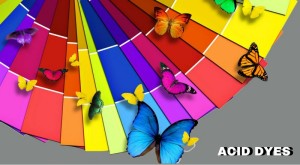
The world-wide colorant industry which comprises of pigments, dyestuffs and the intermediaries runs into billions of dollars. The textile sector is one of the major users of colorants and India is one of the leading suppliers of textile garments and furnishings world-wide. Therefore there is a greater emphasis by the marketing brands here to provide top quality products to the consumer. One way of doing this is to adhere to the quality norms laid down by the different stake holders like brands, consumers, regulatory authorities, colorant producers and textile processors.
A strict monitoring for product standardization of dyestuff is the key to fulfilling quality expectations for the resultant fabrics. Dyestuffs contribute towards a significant percentage of textile coloration and varied dyes like direct dyes, acid dyes, reactive dyes etc go into the dyeing process in the textile industry. Acid dyes manufacturers and several manufacturers of other dyes offer dyes with identical color index which however, do not guarantee same performance. This could be due to the differing quality of raw materials or the differences in synthesis methods. Sometimes because of patents being granted to some manufacturers, others tend to produce similar products with some changes which again give different performance attributes. There is therefore a need for the dyestuff manufacturers to develop some sort of systems for standardizing their dyes which will help the application needs of textile industry.
Another factor that puts the onus on dyestuff manufacturers to take the lead in developing the standardization process is the fragmentation of the unorganized textile sector in the country. Moreover, the textile clientele comprises of corporate as well as the SMEs and hand textile processors who normally have no quality inspection infrastructure for incoming dyestuff at their end. At the same time, top quality output can be given by the textile processors if shade rejections are reduced or processing time, energy and water is reduced. The textile processor has to take into consideration the high consumer expectations with regard to colour fastness and the social responsibility issues of not affecting the ecological norms too.
Where ever possible, dye manufacturers resort to several testing procedures and check points to ensure the quality during the synthesis of dyes. This comprises assessing and analyzing the inbound raw materials, chemicals, dye intermediaries for ensuring their adherence to specifications. Testing while the dye synthesis is in progress can be done to obtain the required colour yield and lessen chemical wastages. Testing is done on varied parameters like chemical, physical, toxicological, fastness, effluent related, sustainability and comparisons are made against an external or internal standard.
Sustaining a competitive edge in the global dyes market depends upon the supply of consistently quality products to meet the required demands. Quality control and product standardization lays focus on testing to eliminate defects and also on working out test protocols which will drastically reduce issues leading to flaws in the first place. Multiple stages are involved in the dye manufacture process and hence testing for quality control has to be done for every individual batch against the set standards and this has to become an inherent part of the standardization process for dyes.